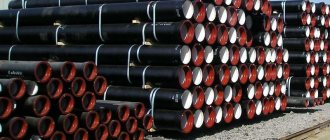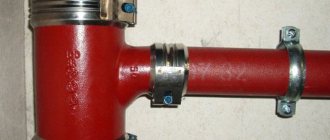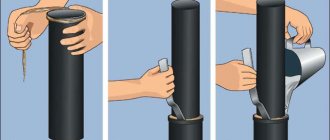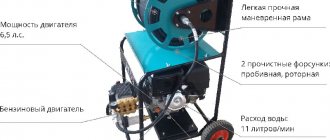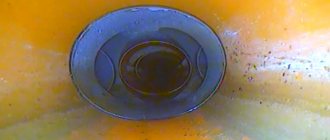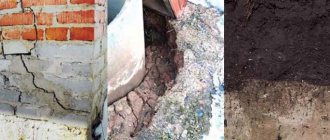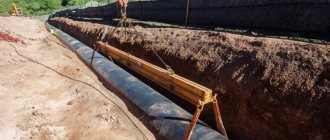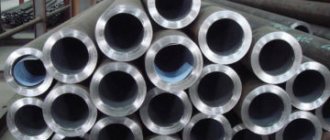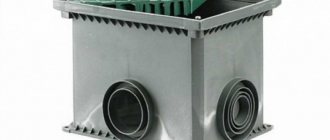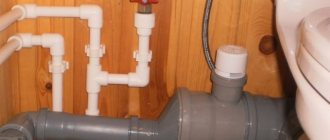Perhaps the most annoying and troublesome breakdown that can occur in your home is a sewerage malfunction. Repair of sewer pipes may be needed for many reasons and at any time (even the most inopportune for you). After all, a modern sewer system is a serious technical complex that serves the entire house and combines a bathtub, toilet, all sinks and other washing machines, including a dishwasher and washing machine. Moreover, internally, all these elements are connected into one network, with many connections and interconnections, which, of course, is not immune to breakdowns.
Thus, if there is a sewerage problem, the entire house may be deprived of its usual amenities for several days. Of course, it is best to entrust the solution to this problem to a special technician who will quickly and efficiently fix the problem.
What can you say about a sewer malfunction:
- Pipes or plumbing may leak
- The plumbing becomes clogged, or the water begins to flow poorly
- Crack in the pipe
- Unpleasant smell
In any of the above cases, immediately after detecting damage (or signs thereof), you need to block or secure the breakdown and call a technician. Further repair of the sewer pipeline will depend on the extent and location of the breakdown.
Required tools and materials
Leaking polypropylene pipe at the junction
To restore damaged sewer sections, you should stock up on the necessary tools:
- paint brush;
- wire brush or sandpaper;
- hacksaw;
- construction knife.
In addition, it is advisable to have the following materials on hand:
- construction adhesive;
- cement;
- liquid glass;
- solvent or degreaser;
- bandage or tape made of fabric;
- clamps or wire;
- rubber.
These tools and materials are enough to seal a joint at a leak or repair a burst pipe. To carry out major repairs, it is worth purchasing pipes and fittings.
How to replace a sewer pipe in an apartment
When completely worn out, the damaged area must be replaced. The services of a road repair specialist, but you can install a new section yourself. If the damaged area is located under a tile or decorative panel, then opening it is necessary. Consider this as an additional cost when repairing the pipeline.
Stages of dismantling an old pipe
Before starting repairs, you need to dismantle the old pipe, turn off the water and disconnect the plumbing fixtures from the sewer. Then do the following:
- If necessary, break the cement screed and free the pipe.
- Disconnect fittings.
- Using a grinder or pipe cutter, cut off the pipe, moving 5–10 cm away from the installation site.
- Remove the sawn part with a hammer and crowbar.
- Fill potholes and uneven areas with cement mortar.
Stages of assembling a new pipeline
When replacing an old cast iron sewer system with PVC, first assemble the fittings and pipes into one system. Then marks are made on the walls, taking into account the slight slope towards the riser. Clamps are attached to the marks. After this, the installation of a new pipeline begins:
- Connect the assembled system to the sewerage inlet using a sealing collar. Make sure that no burrs appear in the cutting areas, otherwise this will cause permanent blockages.
- To connect to the plumbing equipment, the pipeline is extended to the required length.
- The tightness at the joints is checked.
Now you can use the new sewage system.
Causes of sewer pipe breakdowns
Crack at the junction of cast iron and plastic pipes
The main types of sewerage breakdowns are leaks. They usually occur at the junctions of structural parts, sometimes along the element itself.
Causes of leaks:
- High load on a single part. This usually happens when the system is clogged. Increased pressure inside the structure leads to damage in the weakest areas. The system can be restored to normal operation by mechanical or chemical cleaning.
- Freezing of structures in winter also leads to malfunctions. Parts used outdoors are often susceptible to this. But accidents also happen inside buildings. Water expands when it freezes. Ice jam can tear the material of pipes or fittings.
- Poor quality parts or improper installation of the structure also lead to the destruction of individual elements. This requires replacement of gaskets or repair of pipes and fittings.
Depending on the extent of the damage, urgent or major repairs of the sewer system are required.
Leak repair
Experienced craftsmen immediately determine the location of the sewer pipe leak and find a solution to the problem. Most often, a leak occurs at the entrance to the pipe: it is either an inaccurate connection between the siphon and the drain hole, or the siphon and the pipe.
A master can carry out such repairs of sewer pipes without even dismantling the plumbing and the entrance to your sewer system. To fix the problem, an experienced worker just needs to tighten the connections, replace the gasket or seal the entrance to the pipe. This damage can be dealt with in the shortest possible time and without major repair work.
More attention from the technician will be required if the leak occurred due to a poor-quality connection of the sewer pipes themselves, because repairing cast-iron sewer pipes will take a little longer and will require workers to intervene in the system itself.
In this case, the master will first determine what was used to strengthen the pipe connection earlier. His further actions will depend on this. If there is lead caulking, then the joint will need to be cleaned and a new, more durable connection and seal will be required.
And if the connection was cement, first the master will remove the old mortar, check, clean and strengthen the joint, and then fill it with cement again. Experienced craftsmen can carry out such repairs on a cast iron sewer pipe in one visit, without causing much harm to your interior.
Urgent pipe repair
Small leaks in pipes can be sealed with a special sealant
Cast iron structures are often found in old buildings. Breakdowns in such highways are not uncommon. In this case, it is difficult to replace a separate part. Leaks in cast iron pipelines are sealed using sealants.
Coating the leak site with construction adhesive and cement is often used.
- Use a wire brush to remove rust from metal parts.
- The treatment area is degreased.
- Apply a layer of construction adhesive with a brush.
- Cement is poured on top.
Several more layers are performed in the same way. Then you need to dry the cement-adhesive patch. This method is effective for small leaks. In more serious cases, it is worth using another recovery option.
- Perform pre-processing of metal parts.
- The cement is diluted with water and liquid glass is added.
- Soak the bandage with the resulting solution.
- The material is wrapped around the leak site in 5-6 layers.
- The top of the structure is treated with silicate glue.
There are several ways to carry out urgent repairs of plastic pipes without dismantling them:
- Using sealants - the dried and grease-free crack is covered with a waterproof agent.
- Using special tapes, the damaged area is wrapped with material in 2-3 layers.
- Using rubber and clamps - a rubber pad is placed at the leak site. It is secured at the edges with clamps.
- Using soldering.
You can fix a leak in a plastic sewer pipe in a more radical way. For small ones, couplings are used.
- Use a hacksaw to cut out the damaged piece of plastic.
- The edges of the pipe are cleaned of dirt and degreased.
- Sanded to create a rough surface.
- Glue or sealant is applied to the ends of the elements.
- Put on a muff.
Cracks larger than 10 cm are sealed using two couplings and a piece of pipe. The repair technology is identical to installing one fitting.
How to replace a sewer pipe in an apartment
When completely worn out, the damaged area must be replaced. The services of a road repair specialist, but you can install a new section yourself. If the damaged area is located under a tile or decorative panel, then opening it is necessary. Consider this as an additional cost when repairing the pipeline.
Stages of dismantling an old pipe
Before starting repairs, you need to dismantle the old pipe, turn off the water and disconnect the plumbing fixtures from the sewer. Then do the following:
- If necessary, break the cement screed and free the pipe.
- Disconnect fittings.
- Using a grinder or pipe cutter, cut off the pipe, moving 5–10 cm away from the installation site.
- Remove the sawn part with a hammer and crowbar.
- Fill potholes and uneven areas with cement mortar.
Stages of assembling a new pipeline
When replacing an old cast iron sewer system with PVC, first assemble the fittings and pipes into one system. Then marks are made on the walls, taking into account the slight slope towards the riser. Clamps are attached to the marks. After this, the installation of a new pipeline begins:
- Connect the assembled system to the sewerage inlet using a sealing collar. Make sure that no burrs appear in the cutting areas, otherwise this will cause permanent blockages.
- To connect to the plumbing equipment, the pipeline is extended to the required length.
- The tightness at the joints is checked.
Now you can use the new sewage system.
Major renovation
Textile stocking with epoxy resin creates a waterproof coating
If in a building with plastic sewerage water runs through the joints, it is not necessary to dismantle the entire system. Leaks in the joints of sewer pipes can be eliminated through major structural repairs. There are the following methods for this:
- Insertion of smaller diameter pipes into existing networks. To do this, you do not need to open the sewer pipeline.
- Restoring the integrity of pipes using a flexible insert made of textile stocking, which is impregnated with epoxy resin. This creates a new waterproof structure inside the old pipelines.
The use of new technologies makes it possible to repair old mains outside and inside the building without excavating trenches and dismantling the sewerage system.
Sewerage repairs on the top floors of buildings have some peculiarities. Here an air cushion is formed from gases from the waste. They are removed from the system through the sewer ventilation pipe. For this reason, repair of damage is carried out with careful sealing. Otherwise, gases from the waste system will enter the living quarters.
Repair of plastic pipes
One of the simplest types of work in case of a sewerage breakdown is the repair of plastic sewer pipes. Experienced craftsmen are well aware that repairing such pipes, in principle, makes no sense due to the imminent secondary breakdown. With each intervention, the strength of the product itself is significantly reduced. In this case, replacing the old pipe with a new one will be much cheaper than its further maintenance.
Of course, in the case of small cracks, the technician, at your request, can cover them with sealant, but you need to understand that this is only a temporary measure, and further replacement cannot be avoided.
Common mistakes when repairing a sewer system
The most common mistakes when installing and repairing drainage structures are the following:
- During installation, the wrong slope of the pipes is chosen. This leads to disruptions in the operation of the entire structure. A large angle of inclination contributes to the gradual settling of solid particles on the inner surface of the parts, which are not completely washed off with water. Insufficient slope can cause siltation of the pipeline and the formation of traffic jams.
- Poor sealing of the joints between various parts quickly leads to the need for repair work.
- Often malfunctions are caused by the lack of inspections and ventilation of the sewer system - they are simply removed during renovations in the house.
To restore the functionality of the sewer system, do not use corrugated pipes instead of siphons. They become clogged faster and more difficult to clean.
Replacing a sewer riser
The procedure for replacing a pipeline with your own hands includes dismantling old equipment and installing new
Please note that when changing the riser in an apartment building, it is advisable to also change the areas located in the interfloor ceiling, that is, in order to carry out repair work, you will have to negotiate with the neighbors. However, if this is not possible, only the area located in the apartment is changed
To dismantle the old cast iron riser you will need the following tools and materials:
- Angle grinder (aka grinder) or pipe cutter;
- Chisel and screwdriver for removing cut pieces and fragments;
- Hammer, nail puller (or crowbar) for loosening and removing stuck areas;
- Perforator for breaking cement;
- Polyethylene to plug the holes;
- Grinding machine for preparing a pipeline section for installation of a new pipe;
- Protective equipment (gloves, goggles or face shield) for the employee himself.
The dismantling process includes the following steps:
- First, agree with your neighbors about the need to shut off the sewer, make sure that no one is using the system;
- Initially, two horizontal cuts are made: the first 10 cm below the ceiling, the second 80 cm above the tee. The cut is made approximately half the thickness of the pipe;
- Using a hammer and chisel, hit the upper cut first, and then the lower one. The pipe should crack and be easily pulled out;
- The area located near the ceiling is covered with film. Next, you should dismantle the lower part of the sewer system with a tee;
- Try to loosen the part using a crowbar; if this does not work and the tee is securely fixed with cement mortar, in this case you should use a hammer drill. If it is not possible to remove the tee, it is simply cut off with a grinder at approximately 3 cm from the socket.
- It remains to prepare the pipeline for installation of a new section. The ends are cleaned of dirt and traces of corrosion, and then processed with a grinding machine.
Installation of a new riser
To carry out this work you will need:
- Plastic sewer pipe with a diameter of 110 mm;
- Tee;
- Rubber cuffs and expansion pipes for the transition from plastic to cast iron;
- Clamps and fasteners;
- Bubble level;
- Soap to facilitate the entry of one pipe into another.
The riser is assembled in the reverse order of dismantling, that is:
A rubber cuff is inserted into the socket of the cast iron pipe. A tee is attached to the lower part, and a special adapter is attached to the upper part. The joints are sealed with flax or special silicone
Please note that all connections must be tight, otherwise leaks are inevitable. Clamps are installed to secure the pipes. Typically, for rooms with a standard ceiling height of 2.5 meters, three mounting points are sufficient. The structure is being assembled
The compression pipe required to switch from cast iron to plastic is mounted with a tee. After this, all sections of the pipeline are connected and installed in their places. You can check the operation of the system.
Preventive measures against sewerage breakdowns
To avoid having to repair breakdowns and malfunctions in the sewer system, it is worth taking preventive measures in advance.
- It is necessary to buy high-quality products with the required technical characteristics.
- When installing individual parts, special attention should be paid to the joints. They need to be well sealed.
- Parts of the waste system that are operated at sub-zero temperatures are subject to insulation. Here they use foamed polyethylene or a foam shell.
A properly installed drainage system made from quality materials can last a long time and reliably. If necessary, you can repair sewer pipes without opening the structure yourself.
Causes of emergencies in the sewage disposal system
An experienced owner knows that the sewer riser in an apartment requires constant attention and systematic care. Malfunctions that have arisen in the system can be eliminated with your own hands if the smell of sewage in the room is associated with problems that arise in the pipe distribution inside the apartment. What causes a network emergency?
Damage to the pipes inside the house leads to the appearance of an unpleasant odor in the apartment. In this case, the repair of sewer pipes is carried out by the maintenance office. A leak in the bathroom occurs as a result of the formation of a crack or fistula in a certain section of the pipe. An inspection shows that hidden sewage leaks most often appear on plastic pipes installed in the bathroom. The technician needs to determine in advance the tightness of the connection between the sink, sink and other sanitary equipment. Irregularities in the operation of the ventilation sewer system lead to the appearance of pressure, and a missing water plug allows foul odors to enter the room.
Repairing sewer pipes in an apartment with your own hands
A problem can arise unexpectedly in any part of the pipeline, and no one can predict where the defect will appear. In most cases, urgent repairs of sewer pipes made of cast iron (or plastic) have to be performed due to the following faults:
- The occurrence of unpleasant odors emanating from elements of the sewer network. This clearly indicates that one or another element of the system has cracked. Or there is a major blockage in it - which is also a fairly serious problem.
- The occurrence of leaks directly at the joints of elements of the sewerage system;
- Pipe blockage (complete or partial).
The last of the above malfunctions is observed in domestic sewers very, very rarely, but still sometimes you have to deal with such a disaster. Typically, blockages occur in siphons located under sinks or sinks in the kitchen. A variety of debris is likely to accumulate in pipeline assemblies, especially in kitchen ones. Any person can remove it, and without the use of any equipment - just use the familiar plunger. A few confident movements with this simple device, and the blockage will disappear in no time. The main thing is not to forget to thoroughly rinse the cleaned system with water, and under pressure.
In cases where the specific design of the sink requires the presence of a special hole that provides it with reliable protection from excessive filling, in other words, from overflow, this overflow must be closed before using the plunger. Otherwise, you will continuously drive air through the sewer pipes. There will be no result. For the simple reason that the blockage will not go away.
You can also use a plunger in cases where the toilet becomes clogged in a private house or apartment for one reason or another.
Here, however, it is important to note that the proposed solution to the problem does not always help. It is also possible that the plunger will have an effect, but not to the extent necessary
However, no matter what, it’s still worth trying to use this remedy. If the expected results are not obtained (that is, the clog that has formed remains in place), you must try to clear the toilet drain using chemical cleaning compounds. If this is also useless, then in any case you will have to use a special cable to carry out cleaning, and in some situations (for really complex blockages) you will need to call professionals “armed” with special equipment.
The quality of assembly of the sewerage system directly determines its service life. In addition, there is a high probability that sewer pipes will need to be repaired. But even the highest quality assembly will not be able to guarantee you a 100% probability of no accidents or any other urgent situations. Therefore, it makes sense to take a closer look at the basics that will make it possible to independently eliminate problems that arise with the pipes of the sewer system.
Troubleshooting solutions
Any sewer system, even one built from the most expensive and modern materials and operated as carefully and carefully as possible, is not immune from emergency situations. A significant volume of organic and inorganic waste passes through pipes every day. Over time, they inevitably accumulate, settle on the walls, causing difficult outflow and unpleasant odors.
We recommend that you read: How to choose and install a chimney pipe for a bathhouse?
In order not to lead to a complete blockage of the pipes, it is worth doing periodic preventive maintenance.
There are several ways:
- Electromechanical. A mobile cleaning device with an electric drive is used.
- Hydrodynamic. Special installations are used that supply water under high pressure into the pipeline. Powerful jets of liquid effectively and quickly deal with blockages of any complexity.
- Mechanical. Involves manual cleaning using a plunger or plumbing cable.
- Chemical. Accumulations of organic matter are dissolved using aggressive chemical compounds: alkaline, acidic or saline.
External sewerage repair
External sewerage is always more difficult to repair. This is explained by the fact that pipes, as a rule, run underground, and all manipulations have to be done almost blindly.
Pipe replacement work is carried out in two ways:
- Relining. The essence of the method is that another, smaller diameter, is pulled inside the old damaged pipeline. The old pipeline will act as additional protection, but the sewerage capacity will noticeably decrease.
- Burstlining. Here the old pipe is cut along its entire length, expanded and pressed into the ground. It turns out to be a kind of channel into which it is easy to tighten a new pipeline (its diameter can be equal or even greater than that of the original system).
It is convenient to remove blockages in underground pipeline networks using the hydrodynamic method. A flexible hose equipped with a special nozzle is inserted into the pipe. Water is supplied to the hose under high pressure, the jets of which simultaneously break up blockages and move the installation along the pipe.
When is sewer repair necessary?
Sewerage is a system of pipelines connected to plumbing and household appliances. The purpose of this design is to drain wastewater from the premises. If the system is mishandled or worn out, malfunctions occur and repairs are required.
Common problems and reasons for their occurrence
Most often, residents are faced with the problem of clogged drains. There are 2 reasons why this happens:
- When installing the pipeline, the builders violated the technology, which led to the formation of stagnant areas. In a private house, due to improper design of the system, the system freezes and an ice plug interferes with the outflow of water.
- During operation, the sewage system was used incorrectly and preventative cleaning was not carried out. Animal fat, hair, and food waste enter the system and form impenetrable plugs at the turning points of the pipes.
Another problem is the natural wear and tear of the pipeline. Constant loads lead to leaks, cracks, and the formation of fistulas, and this cannot be done without repairs.

